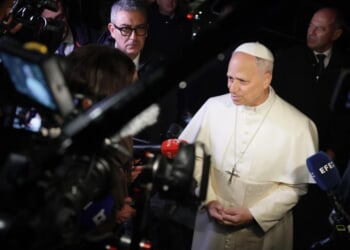The publication of the summary document of the CEI synodal journey, entitled Lievito di pace e di speranza (“Leaven of Peace and Hope”), is causing quite a stir. It seems to welcome and embrace the claims of groups such as Gionata project, which want to legitimize homosexual and gender ideology within the Catholic Church. This comes after a sacrilegious “LGBT jubilee” took place in St. Peter’s Basilica in the Vatican in early September as part of the events linked to the Holy Year 2025.
The most serious aspect of this situation, apart from the inconsistency of wanting to be Catholic while continuing to live in a state of mortal sin and without the slightest intention of trying to change one’s life, is that it is now clear that among some Catholics, including those at the top of the Vatican hierarchy, the idea has taken hold that there is a homosexual identity (originating from the Creator), and not a disordered tendency (originating from Original Sin).
Faced with this confusion, it is appropriate to reiterate what the Catechism teaches:
Basing itself on Sacred Scripture, which presents homosexual acts as acts of grave depravity, tradition has always declared that “homosexual acts are intrinsically disordered.” They are contrary to the natural law. They close the sexual act to the gift of life. They do not proceed from a genuine affective and sexual complementarity. Under no circumstances can they be approved. (Catechism of the Catholic Church, 2357)
That said, it may be interesting to understand what the LGBT ideology is based on. I will not examine the issue of homosexuality and transsexuality from a psychological point of view—both for reasons of space and because it goes beyond my expertise—but I will examine how the ideology that seeks to normalize these tendencies took shape and how it spread throughout the world. While the issue of homosexuality has always existed, the tendency to legitimize this practice and make it the new norm is entirely new.
Among those who paved the way for this trend were thinkers and intellectuals such as Michel Foucault and Simone de Beauvoir, who said that “one is not born, but rather becomes, a woman.” However, the real turning point came with the publication of two studies on the sexual habits of Americans (Sexual Behavior in the Human Male and Sexual Behavior in the Human Female) by entomologist Alfred Kinsey, later known as the Kinsey Report.
The Kinsey Report set out to reveal the true sexual habits of Americans based, according to the author, on serious investigations. Reading the Report, it emerges that the practice of homosexuality was so widespread that it could be considered part of normal life. But that’s not all: Kinsey also considers relationships between adults and children, as well as childhood sexuality, to be common and therefore normal. The problem—apart from the fact that the prevalence of a practice, however widespread, never justifies it—is that a significant portion of the “scientific” data presented by Kinsey was obtained from the US prison population, who were in prison precisely for sexual crimes. In short, Kinsey cheated from the outset to obtain the desired result.
The Report was published and disseminated by the Rockefeller Foundation, which organized a massive advertising campaign. It was hugely successful, especially considering that the Global Sexual Revolution (the apt title of Gabriele Kuby’s study), in which we are still immersed, was already underway.
The invention of gender ideology, however, is attributed to John Money, a psychologist and surgeon who coined the term “gender identity.” For Money, “sexual identity is essentially a product of society and, therefore, malleable and flexible at birth” (Nerozzi D., L’uomo nuovo, 2008, p. 38). It will then be up to the individual “freed” from social conditioning to choose whether to be homosexual, heterosexual, male, female, transsexual, etc. (to date, some have identified more than 70 genders).
This is the heart of gender ideology: it is not a question of discerning an objective fact, i.e. putting into practice the adaequatio rei et intellectus by recognizing a person’s belonging to the female or male sex, but of determining reality in a subjective way by choosing which gender to belong to. This mindset is also at the basis of transhumanism: why, in fact, limit oneself to identifying as homo sapiens? Why not become something more, perhaps by hybridizing machines or modifying one’s DNA?
Returning to John Money, who also supported the normality and lawfulness of all possible and imaginable perversions (including pedophilia), it is worth remembering that he was not just a theorist: as a surgeon, he also had the opportunity to put his theories into practice, operating on a patient to make him “change sex” (quotation marks are necessary, as changing sex is materially impossible).
This was the case of David Reimer, a child who, following an accident in which his genitals were damaged, underwent surgery at 22 months to be transformed into a girl, Brenda. Following this apparent success, Money unfortunately mutilated many other young patients. Over time, several enormous problems emerged for the poor victims who ended up under Money’s scalpel. David/Brenda Miller himself, after a very troubled life during which he also tried to reclaim his identity, died by suicide. None of this affected Money’s high reputation, nor did it prevent his theories from spreading like poison throughout the world.
Another important milestone in the spread of this ideology was marked by the removal of homosexuality from the list of diseases in the 1973 edition of the Diagnostic and Statistical Manual published by the American Psychological Association. This decision was made in a climate of violence and intimidation that had little to do with what should have been a debate among men of science. In the 1990s, gender ideology was taken up by Judith Butler and Teresa De Lauretis, who emphasized the supposed mutability, temporariness, and fluidity of gender identity.
The rest is contemporary history: these ideas, once confined to academic and limited circles, have forcefully entered the daily debate and much of the collective imagination. The world of entertainment and music, intellectuals and journalists, television and radio, private foundations and international organizations such as the UN, UNICEF, WHO, etc., have competed—and continue to compete—to publicize the LGBT ideology and relaunch it ad nauseam. The month of June, which for Catholics is the month of the Sacred Heart, has become the month of homosexual pride, with raunchy parades marching through the streets of cities around the world. In many Western countries, relentless propaganda has finally given way to explicit forms of repression of dissent: in the name of inclusion and tolerance, dissidents are discriminated against and persecuted.
This is another reason why it is particularly painful to see how, even within the Catholic Church, LGBT ideology has gained ground, aided by a false idea of charity and mercy. The problem is not only that sin is being blessed (Fiducia Supplicans)—which is an act of unprecedented gravity—but that we are witnessing the total distortion of Catholic anthropology.
The Catholic view of man, in fact, teaches us that the human being is first and foremost a creature, composed inseparably of soul and body, with a sex that indicates his place in creation, and that he is willed as such by the Creator and placed by Him in a natural order that he is called to respect. In gender ideology, on the contrary, it is the human being who determines himself, who sees himself essentially as an intellect that decides what to be and with which gender to exercise sexuality, who perceives the body as something to be altered at will and who, by denying an objective natural order, reduces everything to oppressive social prejudices (the expression “sex assigned at birth” is most revealing).
All this highlights the extreme gravity of the publication of an ambiguous and harmful document such as “Lievito di pace e di speranza” which—far from helping those in a problematic situation—opens the doors of the Holy Church to a deadly and destructive ideology that deludes people into thinking they can determine their own nature in the name of a false idea of freedom which, in reality, is only arbitrariness and sin.
Photo by Raphael Renter on Unsplash













